
The Narrative of Walking Cloud1
by Walking Cloud (Mąxíwimą̀nįga)
(463) My name is Mauchhewemahnigo (Walking Cloud). I was born on the Wisconsin River. I was about ten years of age when the treaty was held at Prairie du Chien,2 where they fixed the boundaries between the Winnebagoes and the Chippewas and our cousins the Sioux. I went with my father to that treaty. My squaw's name is Champchekeriwinke (Flash of Lightning). Her uncle was Hootschope (Four Legs).3 She was born at his village on Lake Winnebago. During the Black Hawk War, my father had his lodge near La Crosse. I did not go to the war; I was too young. But my brother did. His name was Seeorouspinka. General Dodge sent a messenger down to Prairie du Chien, and said he wanted the Winnebagoes to go into the war and help the Great Father punish the Sacs. Our (464) people, who were named in this call, did not want to go to war. But the messenger, after we had all arrived in Prairie du Chien, picked out Winnebago Black Hawk (my father), and my brother, and they went up the Wisconsin River with a party of white soldiers and officers from Fort Crawford. They met a number of Sacs coming down on a raft made of canoes tied together. The Winnebagoes and the whites killed most of the Sacs in this party.4 Winnebago Black Hawk was the guide of this expedition.
After the battle of the Bad Ax, the Winnebagoes went on their fall hunt. My father, Winnebago Black Hawk, had a hunting village on the La Crosse River, near where Bangor now is.5 There were about eighteen hunters in the camp. One day a party of young men were on the chase, having gone up one of the branches of the La Crosse River, towards the head of the Kickapoo. On their return, they came across the camp of the Sac chief, near a little lake. There was much excitement among the hunters. They knew the Great Father had ordered all Winnebagoes to capture the head man of the Sacs, and they did not at first know what to do. They concluded, without talking to the Sacs, to go to their village and report to Winnebago Black Hawk. There was a council held that night in the Winnebago village. It lasted all night and all next day. I remember this council very well. Both Red Wing, here, and I were young men and stood by while the old men talked. The day after the council was over, Winnebago Black Hawk asked three young men to go to the Sac chief, Black Hawk, and tell him that the Winnebagoes had been ordered by General Street, the agent at Prairie du Chien, to take him whenever they saw him and bring him in to Fort Crawford. The three young men were (465) Nenohamphega (Lighting the Water), Wakuntschapinka (Good Thunder), and Chatschunka (Wave). Wave was an interpreter, being one-half Sac and one-half Winnebago. These three went through the woods to the camp of the Sac Black Hawk, and delivered to him the speech of Winnebago Black Hawk. They advised the Sac chief to go peaceably to Prairie du Chien, and doubtless he would not be harmed. The Sac chief said: "You want us to be killed by the whites; as you so wish it, we will go."
So the Sac Black Hawk, and those who were with him, were brought back to our village; and a number of our warriors went down to Prairie du Chien with them, and delivered them up to General Street. One-eyed Decorah was not of this party. I am positive of it.6 He remained at our village all the time. He was not a good man, and not then a chief. After the treaty and the payment, he was made a chief through the influence of the American Fur Company and the Indian agent, General Street. The agents and traders had a way of putting aside old chiefs, for (466) new ones whom they had gained to their interest. After the Black Hawk War, One-eyed Decorah married two women, and then went off and started a village of his own, on the Black River. He was always afraid somebody would entice his women away. He was ugly and jealous.7 H. M. Rice got me [in 1850, or 1851] and many of my friends to go to Long Prairie, Minn., and make up our minds about that country.8 We were to see if we would like it as a home. We went there and did not like it, so returned home that same fall.
Captain Hunt got us [in 1873] to go to Nebraska. He promised me a span of horses, a wagon, and $200; and said I should get them when I arrived in Nebraska. But I never received them. We soon came back.9
I have been living for thirteen years on my present homestead, in the town of Albion, Jackson County.
The Winnebagoes came from the sky, the old Indians say. They settled first at the Red Banks. They first met the French, who came in large boats to trade with them, near Green Bay. The French were always our good friends. We never had any trouble with them.
All of the other tribes of Indians have tried to kill off the Winnebagoes. The Sioux were the most ugly towards us, though I am told they are our cousins. In old times we had much fighting with the Chippewas, but not in my recollection. We have been at peace with everybody, since the Great Father at Washington commanded us to be at peace or he would take away all our guns. The Menomonees have always been our good friends.
Our fathers used to fast and pray, that the spirits might appear to them. Sometimes they would pray that the water spirit might come and wet the corn-fields. This he would do when he was in good humor; but when he was in bad humor he would bring a good deal of water on the (467) land and make a flood. The water spirit, I am told, has a long tail winding around his body, and has two horns. But in my day he has not appeared to any of our people, and we no longer pray to him.
You ask me about a future life. I cannot see how a person may be taken to another world and come back and tell about it. Old people used to tell us that the dead, when washed clean by the Great Spirit, could be sent back to earth. And some believe this, even now.
One thing is certain. The body rests in the earth four days. During that time we take food and place it on the grave, that the body [soul] may not starve. After four days, the body rises and starts out alone, to the happy hunting-ground. A spirit comes to guide the body on its way, unseen. They come to a swift-running stream. They must cross it on a slender pole. If the body is that of a bad Indian, it sinks in the river and never lives more. If it is a good Indian, it walks steadily and crosses the pole. A woman stands on the farther bank, and receives the new comer. The woman asks the stranger his name. When she receives it, she says: "You are good; you shall always live in the happy hunting-ground." This woman is neither old nor young, nor will she ever be old; for the Great Spirit placed her there at the beginning of the world, and she has always looked the same.10
Notes to the Text
1 The interview took place May 18, 1887, at the Winnebago settlement in the town of Albion, Jackson county. Moses Paquette was the interpreter, and afterwards revised the MS. of the narrative, which I have given as nearly as possible as it fell from Walking Cloud's lips. As with that given by Spoon Decorah, this story has ethnographic rather than historical importance. I think that these two narratives are the last of any value which may be obtained from the Winnebagoes of Wisconsin, for the reason that the younger generation of men have no traditions to which we can attach any scientific importance. Spoon and Walking Cloud were regarded by their fellows as practically "the last of the Mohicans," and their offspring are allowing the old tales to die with them. Spoon died in 1889, but Moses Paquette writes me (Black River Falls, Nov. 6, 1895) that Walking Cloud still lives; his squaw, however, is dead. — Eᴅ.
2 Aug. 19, 1825. — Eᴅ.
3 Wis. Hist. Colls., x., p. 114, note; Wau Bun (1856), p. 85 [70]. — Eᴅ.
4 During this interview, an old Winnebago named Red Wing was present. He said that he took part in this affair, and killed four Sacs. In the recital of his alleged achievement, be seemed to take a lively satisfaction. See reference to this butchery, in Wis. Hist. Colls., xii., pp. 254, 255. — Eᴅ.
5 Cf. Spoon Decorah, ante, p. 454. — Eᴅ.
6 Cf. Karrymaunee's statement in Wis. Hist. Colls., vii., p. 332; Clark's statement in viii., p. 316; and Dr. Draper's note on the last citation. Indian Agent J. M. Street made official report that upon Aug. 27, 1832, at 11 a. m., "Black Hawk and the Prophet were delivered * * * by the One-eyed Decorah and Chætar, Winnebagoes, belonging to this agency." Official contemporaneous documents are our only reliable sources of information. Indians are phenomenal boasters, and when an act of importance, that may win white men's favor, has been achieved by any of them, there are not lacking those who claim a share in the proceeding. It does not take long among the aborigines for an historical event to pass into shadowy tradition, fit material for any story-teller among them who has an active imagination. Thus it has come about, for instance, that there are as many burial-places of the Sac Black Hawk, in Wisconsin, as Homer had native towns; and any well-informed Winnebago can show you, in his neighborhood, some cave or bluff or ravine where Black Hawk hid during his flight. White historians are thoroughly informed as to the burial place of Black Hawk, in Iowa; but the unlettered savage tale-bearers are as mystified over him and his deeds as though he were a tenth-century hero. I have been surprised, in visiting among old Wisconsin Winnebagoes, to find that only a few of them seem to remember having heard anything about the Prophet, one of the most marked characters in the tragedy of 1832. — Eᴅ.
7 Cf. Spoon Decorah, on the One-eyed Decorah (Big Canoe), ante. — Eᴅ.
8 Cf. Moses Pauquette in Wis. Hist. Colls., xii., pp. 407-409. — Eᴅ.
9 Ibid., pp. 412-414. — Eᴅ.
10 Cf. Schoolcraft, History of Indian Tribes, ii., p. 48 [?]. — Eᴅ.
Commentary. "Mauchhewemahnigo" — this is for Mąxíwimą̀nįga, a Bird Clan name. It comes from mąxíwi, "sky, cloud"; mąnį, "to walk"; and -ga, a personal name suffix.
 |
| J. O. Lewis |
| The Treaty of Prairie du Chien, 1825 |
"the treaty was held at Prairie du Chien" — a council held at Prairie du Chien August 19, 1825, to determine formal boundaries among the northwestern tribes, and to bring into effect a general peace. The tribes participating were the Sioux, Sac and Fox, Menominee, Ioway, Hocągara, Ojibwe, Ottawa and Potawatomi.
"Champchekeriwinke" — for Jąbᵋjikerewįga, "Lightning that Flashes Suddenly." From jąp, "lightning," (but also "to glance, focus the eyes, blink; power of sight; both eyes taken together; to have one’s eyes open, to look, to open his eyes"); jikeré, "to make a sudden movement, to do suddenly, to do in a startled condition; to bluntly say this or that once only" (Miner), but compare jąp jíkere, to flick open one's eyes (Helmbrecht-Lehmann); -wį, a feminine gender suffix; and -ga, a personal name suffix. It was believed that lightning was the flashing of the eyes of Thunderbirds.
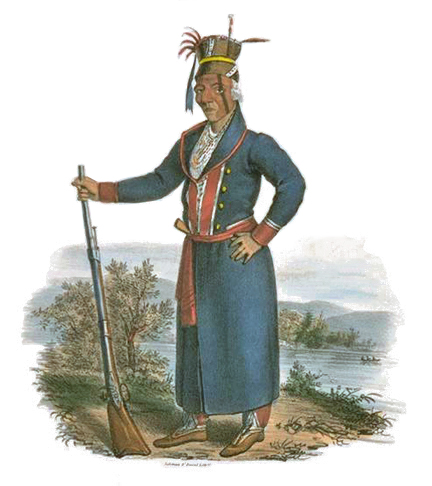 |
| Four Legs, 1827 |
"Hootschope" — for Hu-jop-ka. Thomas George tells us that he was, "about 5 feet 10 ½ ins. high, weighing about 190 lbs., broad shoulders, muscular." He was an incomparable orator and earned for himself the nickname "Thunder Speaker" (Wakąjait’eka ?). Four Legs was not only the chief of the largest village, but "he was the most noted hero of his tribe." Once in his youth he had to hide in the hollow of a tree for three days to avoid capture by U. S. soldiers.1 He was also known as "Old Dandy" for his careful attention to his ostentatious dress. His demise is recounted by Mrs. Kinzie:
Preparatory to this event, the great chief of the nation, Four-Legs, whose village we had passed at the entrance to Winnebago Lake, had thought proper to take a little carouse ... Poor Four-Legs could not stand this full tide of prosperity. Unchecked by the presence of his Father, the agent, he carried his indulgence to such excess that he fell a victim in the course of a few days. His funeral had been celebrated with unusual pomp the day before our arrival, and great was my disappointment at finding myself too late to witness all the ceremonies. His body, according to their custom, having been wrapped in a blanket, and placed in a rude coffin, along with his guns, tomahawk, pipes, and a quantity of tobacco, had been carried to the most elevated point of the hill opposite the fort, followed by an immense procession of his people, whooping, beating their drums, howling, and making altogether what is emphatically termed a "pow-wow." After the interment of the body, a stake was planted at its head, on which was painted in vermilion a series of hieroglyphics, descriptive of the great deeds and events of his life. The whole was then surrounded with pickets of the trunks of the tamarack-trees, and hither the friends would come for many successive days to renew the expression of their grief, and to throw over the grave tobacco and other offerings to the Great Spirit.2
 |
| Four Legs’ Village on Doty Island, 1830 |
"his village on Lake Winnebago" — his village, located on Doty Island in Lake Winnebago, was probably the largest village of the Hocąk nation. Juliette Kinzie mentioned it, "Four-Legs' village, at the entrance to Winnebago Lake, a picturesque cluster of Indian huts, spread around on a pretty green glade, and shaded by fine lofty trees.3 ... After partaking of our dinner, we stepped on board our boat, and, the wind having risen, we were carried by the breeze to the farther verge of the lake, and into the entrance of the river, or, as it was called, the Winnebago Rapids. On the point of land to the right stood a collection of neat bark wigwams — this was Four-Legs' village."4
"Black Hawk War" — in 1804 the United States government made a treaty with the Sauk Nation in which the latter would cede all their land east of the Mississippi. The terms of this treaty were not perfectly clear to most of the tribe. The War of 1812 saw many of the Sauks fighting on the British side. After the war, a new treaty was made in 1816 confirming the stipulations of the initial treaty. The Sauks later claimed that the government said one thing to them verbally and enacted another in print. Saukenuk, the chief village of the Sauks on Rock Island (41.518661, -90.541708), was the birthplace of Black Hawk, and now that he was chief, it was his stated intention to hold onto it. When in 1829, the Sauks returned from their winter hunt, they found the area occupied by white settlers. After a year of cold war with the settlers around Saukenuk, Black Hawk's band returned from the winter hunt, only this time they brought with them over 200 Kickapoo allies. Things came to a head in 1831 when the government enlisted troops to force Black Hawk and his allies to lands west of the Mississippi. Black Hawk retreated and after an armistice, began looking for allies. He was misinformed by another chief that the British would back him along with many of the tribes presently in Illinois. Black Hawk's hopes were buoyed when he was joined by the Winnebago Prophet, the head man of the mixed village of Prophetstown in Illinois. However, he brought very little with him. The Winnebago Prophet had argued that Prophetstown was not covered by any agreement, and that his band could legally cross over and join the Indians living in his town. Over-confident, Black Hawk's band reentered the lands east of the Mississippi in April, 1832. Government troops and Illinois militia mobilized. The Potawatomies and Hocągara largely held back, and the bands of the latter nation under Wakąga were actually enthused to fight against him on account of past hostilities. It also soon became clear that the British had no intention of supporting his campaign. The government sent forward the Illinois militia to reconnoiter, but they were surprised and routed by a force of only 40 warriors at the Battle of Stillman's Run. Black Hawk moved his civilians up to Lake Koshkonong, where the local Hocągara and Potawatomies became raiding white settlements. By June 15, Colonel Henry Dodge's command had caught up with a band of raiders and defeated them at Horseshoe Bend on the Pecatonica. On June 26, Black Hawk repelled a militia command under Major John Dement. By July, Black Hawk had lost his Hocąk and Potawatomi support, and being pressed by troops from Ft. Winnebago, retreated from Lake Koshkonong. The militia forces caught up with Black Hawk at Sauk City, Wisconsin. He attempted a successful rear guard action, saving his civilian population, but was severely defeated in the action, suffering heavy losses. Black Hawk's band, now suffering from starvation, were now in full retreat. When they reached the Mississippi, Black Hawk and the Prophet decided to flee north to seek protection from the Ojibwe, but only 50 of his band followed him north. The rest were at Bad Axe on the Mississippi, where the civilians attempted to cross while the warriors fought against the main force. The result was a massacre in which 260 of the band were killed out of the 500 that had survived to that point. In a pursuit in the days that followed, a Dakota force allied with the government killed 68 of the fleeing band and took 22 prisoners. The Hocągara county 50-60 scalps. Nearly half the band had been rubbed out before escaping west of the Mississippi and rejoining the tribe. On August 27, 1832, Black Hawk and the Prophet were persuaded by Hocąk emissaries to surrender to Joseph Street at Prairie du Chien. Although prisoners of the United States, they soon became celebrities and toured widely in the east.5
"La Crosse" — located at 43.838203, -91.238397. The origin of the name of this city is revealed by Moses Pauquette:
The vigorous game of la crosse now-a-days familiar to patrons of state and county fairs of this section ... was in earlier days much played by the Winnebagoes. It was usually played at La Crosse, — Prairie la Crosse deriving its name from this fact,— during the general rendezvous after the winter's hunt. The Winnebagoes having always clung to the water-courses and heavy timber, during their winter's trapping and hunting, would float down the rivers to La Crosse, and there have their feasts and la crosse games, meet the traders and indulge in a big spree.6
 |
| Sikuruzᵋpįga, 1897 |
"Seeorouspinka" — corrected to Secorouspinka,7 is for Sikuruzᵋpįga from si-kurus-pį-ga, where si means, "foot"; kurus can mean, "to accept"; pį here would mean, "he likes"; and -ga is a personal name suffix. So the name more literally translated would be, "He Likes to Accept that which is for the Foot." "That which is for the foot," refers to moccasins. The name alludes to the practice of women admirers or kin bringing out moccasins to those who were about to depart on the warpath. To say that he likes to accept these means that he is a lover of the warpath. He is found on Kinzie's Receipt Roll at the Nąpasą Village (Sycamore Village) located on the Rock River at 42.185251, -89.137260.
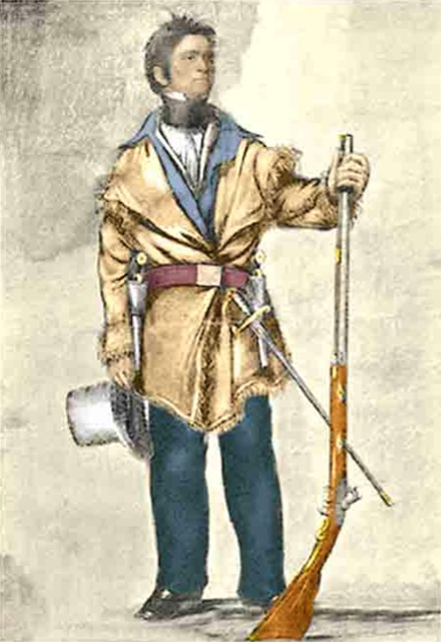 |
 |
|
| George Catlin | William Cogswell | |
| General Henry Dodge, 1833 | Senator Henry Dodge in 1857 |
"General Dodge" — Henry Dodge was born October 12, 1782 to Israel Dodge, a veteran of the Revolutionary War, and Nancy Hunter. He was the first American child born in the present state of Indiana. Israel Dodge divorced his wife and moved to Missouri, where Henry joined him at age 14. He served under his father as Deputy Sheriff in 1805, and in the following year got involved in the Burr Conspiracy, but upon learning that President Jefferson had declared the conspiracy an act of treason, he immediately renounced his participation. In 1806 he was given a commission in the Missouri Militia, and in 1813, he was appointed U. S. Marshall. With the outbreak of the War of 1812, he fielded a company of mounted Missouri Militia, and during the course of the war, rose to the rank of Major General. In an incident of that war, as recalled by his son Senator Augustus Caesar Dodge,
... the lives of five hundred men, women and children of the Miami tribe, [were] not only spared by [Henry Dodge] after they had become his prisoners, but protected from almost instant death by Colonel Dodge, who threw himself between the Miamis and the muzzles of a hundred and ten cocked rifles in the hands of Capt. Marshall Cooper's company, aimed at the Indians by brave but enraged Missourians, who had given way to the ignoble passion of revenge - the Indians having a short time before murdered a number of their kindred and friends.8
In 1827, he moved to Wisconsin, where he commanded militia during the Winnebago War. In October of that year he established himself at what is now Dodgeville. When the Black Hawk War broke out in 1832, he organized and commanded the Michigan Mounted Volunteers (Wisconsin being then part of Michigan Territory). He distinguished himself at the battles of Horseshoe Bend, Wisconsin Heights, and Bad Axe. He was then commissioned a Major and given command of the U. S. Regiment of Dragoons in 1834. He was made Governor of Wisconsin Territory from 1836 to 1841, and again from 1845 to 1848. At that time, the Territory encompassed the present states of Wisconsin, Minnesota and Iowa. He turned down attempts to nominate him for president on the Whig ticket on account of his loyalty to Martin Van Buren. When Wisconsin became a state, he served two terms as its first U. S. Senator from June 8, 1848, to March 3, 1857. He died in Burlington, Iowa, June 19, 1867.9

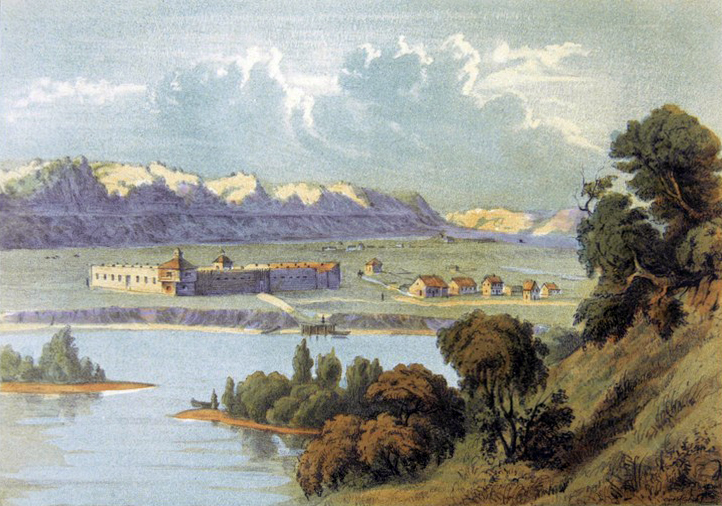 |
| Prairie du Chien in 1830 by Henry Lewis |
"Prairie du Chien" — its French name means, "Prairie of the Dog," and denotes a plain about 9 miles north of the confluence of the Wisconsin and Mississippi Rivers. On an elevation near the Turkey River, the Fox tribe had a large village at the base of which the Dog Band resided. It is from this Dog Band that the whole prairie took its name. The site of the present town was "the principal trading post on the Mississippi; the depot of the fur traders; the ancient meeting-place of the Indians tribes."10 The area was gradually settled by French farmers, and once it fell under the sovereignty of the British Crown, many new British settlers as well. During the War of 1812,
The peculiar position which Prairie du Chien occupied in the Indian country at once pointed it out as a most important place — of the value of which both the hostile Powers were fully cognizant — from the fact that whichever army took possession of it could command that immense territory inhabited by the warlike tribes of the West ... which lay along the west frontier of the United States ...11
The expedition of Zebulon Pike passed through the area and he noted the strategic character of this site and recommended to the War Department that they build a fort there, which was done in 1816 with the erection of Ft. Crawford. It was the frequent site of Indian gatherings for treaties with the United States government, and by 1823, Prairie du Chien was a major steamboat port, although in just a couple of decades, it was eclipsed by Minneapolis.12
"Winnebago Black Hawk" — in Hocąk, Kerejųsepka, listed by Radin as a name in the Bird Clan. Lurie more specifically, lists him as a member of the Hawk Clan (Warrior Clan).13 Jipson recognizes him as one of the important chiefs of the Hocągara.14 Moses Pauquette has this to say about Black Hawk:
The Winnebago Black Hawk was out one day, when he came across the Sac fugitive, and immediately returned to camp and notified his companions. There was a council as to who should go and take the Sac, the Indian agent at Prairie du Chien having given general instructions to all Winnebagoes to bring in the runaway. Winnebago Black Hawk declined to go himself, as he claimed to entertain a superstitious notion that he was not "called" by the Great Spirit to do that kind of work. So One-eyed Decorah took the task upon himself, went and found the Sac leader, and took him into Prairie du Chien.15
His obituary reads, "Black Hawk, the most noted chief of the Wisconsin Winnebago Indians, age 90, died in the town of Brockway, a few miles from Black River Falls. The chief has been well known in the western part of Wisconsin. For the last 50 years, he was always a friend of the whites and on several occasions prevented the Winnebagoes from taking the warpath to settle differences with the whites."16 It transpires that he was a Warbundle owner:
An Indian Chief's war bundle — one of the few owned by museums in the country — was recently given to the Wisconsin State Historical museum, by John Blackhawk, of Greenwood, Wisconsin, great grandson of "Winnebago Blackhawk," an Indian chief of the Mississippi River Valley tribes. Most of these bundles are kept in the possession of the family and are handed down from generation to generation. The entire bundle is wrapped first in matting and then in skin and is worth about $200. It contains several ermine, the sacred animal of that tribe, medicine, herbs of various kinds, charcoal tied in a skin bag, three war clubs, several flutes, fire-hearths and dagger sheath. The only other bundle of this kind that is in the Wisconsin Museum at the present time belongs to the same tribe but to a different clan.17
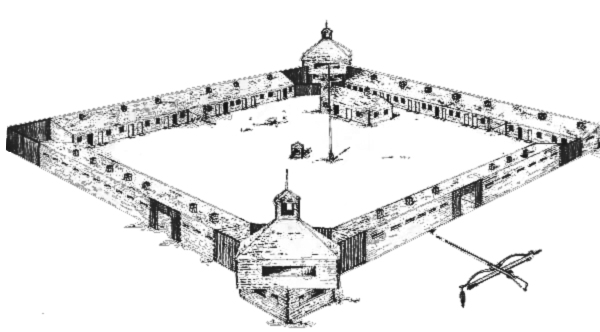 |
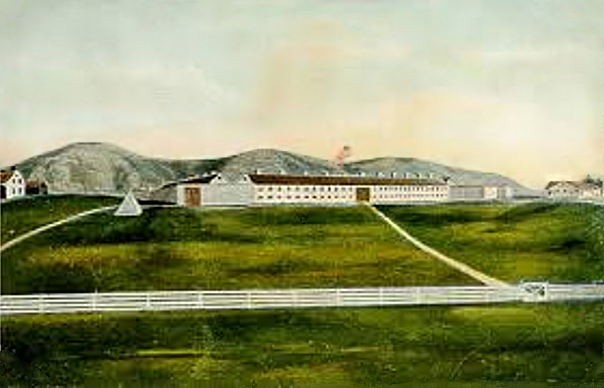 |
|
| Ft. Crawford, 1816-1831 | Ft. Crawford, After 1831 |
"Fort Crawford" — a fort built in 1816 near the strategic confluence of the Mississippi and the Wisconsin Rivers at Prairie du Chien. The site on which the fort was built was subject to flooding, and since it was constructed almost entirely of wood, the timbers began to rot. After the flood of 1826, the fort was abandoned in favor of Ft. Snelling near Minneapolis. With the Winnebago War of 1827, troops were returned to the site, but it was decided to build a new fort on higher ground overlooking the Mississippi. The new fort was constructed mainly out of limestone, and was not fully completed until 1835, although it was occupied in 1832. In that year, Black Hawk surrendered to then Col. Zachary Taylor at the fort. Once the Hocągara had been removed from Wisconsin, the fort lost its raison d’être, and was abandoned in 1849 (although briefly reoccupied in 1855).18
 |
| The Battle of Bad Axe |
"the battle of the Bad Ax" — this is the Battle of Bad Axe, a massacre that ended the Black Hawk War. After their defeat at Wisconsin Heights, July 22, 1832, the Sauks retreated west intending to cross back over the Mississippi. At this point, their Potawatomi and Hocąk allies had slipped away, and starvation had taken a heavy toll among the remainder. On August 1, they reached the Mississippi River with the Army in hot pursuit. During the day, an action of a couple of hours ensued, with significant casualties among the Sauk. Black Hawk decided that rather than crossing the Mississippi under the guns of the U. S. Army, that it was more prudent to flee north. However, a great many of the band refused to follow him further. Most of the force and the civilians trying to escape, were trapped against the river. The gunboat Warrior entered the fray as most of the Sauks attempted to cross the Mississippi. The result was a massacre. Those who did not drown were shot. The fate of those who succeeded in crossing the river was not much better, as the pursuing Dakota allies of the government brought back 68 scalps and 22 prisoners. Black Hawk himself, accompanied by a small band of survivors, escaped north, but on 27 August 1832, under the urging of the Hocągara, he surrendered at Prairie du Chien. The 120 prisoners held by Gen. Scott were released before the end of August.19
"Bangor" — located at 43.891973, -90.990493.
"Red Wing" — he signed the Treaty of 1837.20 In 1832 he lived in the Turtle Creek Village on the Rock River and appears in the census roll compiled by John. H. Kinzie. See the footnote above.
 |
| The Life Cast of Black Hawk |
"Black Hawk" — Mahkatēwi-meši-kēhkēhkwa ("Big Black Hawk") was a Sauk Warleader and chief of the British Band, who gave his name to the Black Hawk War of 1832. He was born in 1767 on Rock Island in the village of Sakenuk, the son of a prominent medicine man, Pyesa. His father took him on a raid against the Osage when he was 15 years old. There he won his first war honor, killing and scalping an enemy. At age 19, he led a large, successful raid of 200 warriors against the Osage. He inherited his father's Medicine Bundle when Pyesa was KIA in a war against the Cherokee. His difficulties with the white Americans began when he opposed the cession of land made in the 1804 treaty of St. Louis. When war with the American state broke out in 1812, Black Hawk allied himself with the Crown. The British gave him the rank of Brigadier General and command over the Indian allies headquartered at Green Bay. Black Hawk's warriors fought in numerous engagements, but in 1816 were obliged to sign a peace treaty with the U. S. recognizing the stipulations of the Treaty of 1804. In 1828, Sauk representatives consented to remove their tribe west of the Mississippi, but Black Hawk with many followers, refused to recognize this treaty's legitimacy. In 1830 and 1831, he made non-military incursions east of the Mississippi without reoccupying the land. In April, 1832, he moved his British Band of 1500 people back into Illinois, but hoped for allies did not materialize, and he began a withdrawal. His retreat was intercepted by the Illinois Militia at Old Man's Creek, and the Battle of Stillman's Run ensued, in which Black Hawk's forces routed the militia. The Sauk then moved north into what is now Wisconsin, headed for the village of White Cloud, the Winnebago Prophet. Only a few of the Hocągara had joined his force, which was made up of Sauk, Fox, Kickapoo, and later some Potawatomies. In a series of battles in Wisconsin, Black Hawk's force suffered serious attrition, culminating in the massacre at Bad Axe. At Prairie du Chien on August 27, 1832, Black Hawk surrendered to Gen. Joseph Street. Black Hawk, along with less than a dozen other leaders, were imprisoned for eight months at Jefferson Barracks. President Jackson, wishing to impress upon these leaders the true strength of white America, sent them on a tour through the east to Washington, where he met them in person. They proved to be quite an attraction in all the cities through which they passed. From Washington they were sent to prison at Fortress Monroe in Norfolk, Virginia, for six months. After their imprisonment, they were sent on a tour back to the west, where they received a positive reception in the eastern cities, but often a negative response in those places closer to the action of the war. In 1833, Black Hawk's autobiography was published. Black Hawk returned to live with his people in Iowa where he died on October 3, 1838.21
 |
| Gen. Joseph Street |
"General Street" — General Joseph Montfort Street (October 18, 1782 – May 5, 1840), was a frontiersman in the old Northwest Territory, and a friend of Henry Clay, Andrew Jackson, and Zachary Taylor. After a stormy career as a newspaper owner in Kentucky, he established himself in Shawneetown, Illinois, in 1812. He was made general of the local militia. In 1827 he became the Indian agent to the Hocągara. He attempted to keep white settlers out of the lands reserved for the tribe, but it proved a hopeless task, so he came to believe that Indian removal was the only answer. In 1832, he was able to keep most of the Hocągara neutral in the Black Hawk War. In 1834, the Fox and Sauk were added as his charges. This diffusion of his labors caused the abortion of his school for the Hocągara at Prairie du Chien, which closed the year that he died.22
"Nenohamphega (Lighting the Water)" — for Nįnahąpiga (> Nįnąpiga), from nį, "water"; -na, the definite article; hąp, "light"; hi, "to cause"; and -ga, a personal name suffix.
"Wakuntschapinka (Good Thunder)" — this is for Wakąjapįga, from Wakąjá, "Thunderbird"; pį, "good"; and -ga, a personal name suffix. Good Thunder signed the Treaties of 1846 and 1865. Lurie records him as a member of the Thunder Clan.23 Kinzie's Receipt Roll of 1832 shows him to be living in Fond du Lac, which was the same village in which Black Hawk was living at the time. Jipson has this to say about Good Thunder:
According to Philip Long[tail], a grandson, Good Thunder was one of three brothers, the two brothers consisting of Ho-ra-pa-gaw, meaning, "Eagle Head" and Shaw-nee-aw-kee, meaning in the Sioux language, "White Goose." The family had Sioux blood. Good Thunder had a son called "Long Tail" who was the father of Philip Long[tail]. ... In 1850 Good Thunder's name was given in the census. His band [was] composed of 59 people, according to a statement made by by his son. Mr. Hall (to Thomas Hughes): Good Thunder's village in Blue Earth County stood on the present site of Good Thunder (44.001162, -94.064167), and consisted of about fifteen to twenty lodges made of bass wood or elm bark: most were (263) square in construction. There were about one hundred persons in the band. In the winter they lived in the timber by the river in smaller tepees [lodges] which were round and ten or twelve feet in diameter, covered with a sort of matting made of leaves of bull-rushes or cat-tails, which were sewed into a thick matting four a five feet wide. The leave were sewed together, one on top of the other with basswood bark fibre. The leaves in such a matting would stand edgewise to the tepee. Some times two layers were used. The tepees were round and matting wound around the poles and part of the end of the matting was used as a door to swing back and forth. In the spring, this tepee was taken down and preserved for the next winter. On the flat by the river, Good Thunder had corn fields. The corn was cured by laying the ears of green corn with husks on, on top of some stones under which was an excavation filled with dry wood. The wood was set on fire and covered the earth allowing it to smolder for two or three days.24
"White Goose" in Sioux is Maġaska. The name Shaw-nee-aw-kee, Ojibwe for "Silver Man," was given to John Kinzie. However, here we learn that a third brother (Hagaga) had the same nickname, and is therefore almost certainly the man otherwise known as "White Goose."
"Chatschunka" — Cašcąga, "Wave," an abbreviated version of this name, is listed as a Waterspirit Clan name by Foster and Lurie. He signed the Treaty of 1832, where he is said to be the son of "Clear Sky." Lurie states, "Clan uncertain since 'Big Wave' should be of the Water Spirit Clan, but the name 'Clear Sky' is not."25 This is probably not true, since Waterspirits are strongly associated with clear skies in contradistinction to Thunderbirds, their mortal enemies, who appear only in dark clouded skies. Therefore, it is entirely possible that "Clear Sky" is a Waterspirit name, even if it does not appear on contemporary lists of that clan. Kinzie's Receipt Roll shows him to be living in the Koshkonong Village in 1832.
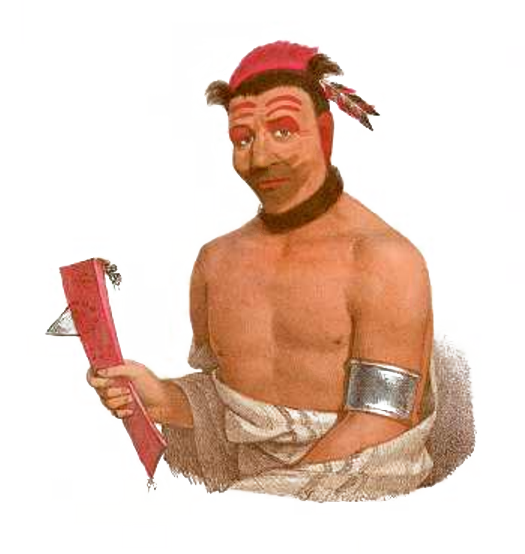 |
| J. O. Lewis |
| Wajᵋxetega, Big Canoe, 1825 |
"One-eyed Decorah" — the third son of "Old Decorah." He is also known by the name "Big Canoe." He distinguished himself in action against the British, for which see, "The Origin of Big Canoe's Name."
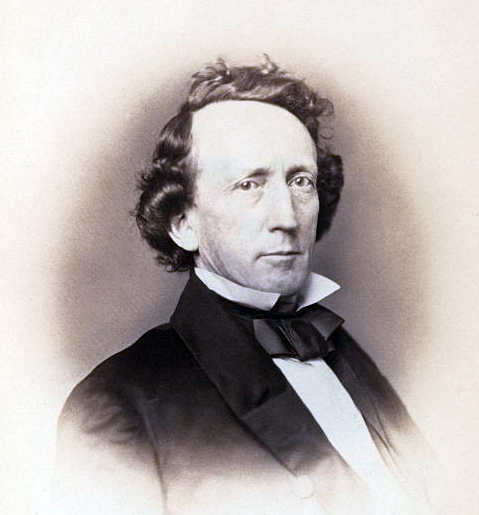 |
| Julian Vannerson |
| Henry Mower Rice (1816-1894) in 1859 |
"H. M. Rice" — Henry Mower Rice (November 29, 1816 – January 15, 1894) was born in Vermont, and went west to Michigan in 1834 to do survey work. In 1839, after securing employment at Ft. Snelling in Minnesota, he became a fur trader to the Ojibwe and Hocąk nations. In the 40's and early 50's he facilitated the establishment of treaties and removals involving the Ojibwe, Dakota, and Hocąk nations. In 1849 he helped establish Minnesota as an independent territory, and as a territorial representative, contributed to the establishment of Minnesota as a state in the Union. He was prominent in the Democratic party in the late 50's and was elected U. S. Senator, a seat he held from May 11, 1858 to March 3, 1863. His attempt to become the Governor of Minnesota in 1865 fell short.26
"Long Prairie, Minn." — this is the territory assigned to them briefly in Minnesota. Publius Lawson give an account of this short episode in the wanderings of the nation:
In 1853, a new treaty was made, by which they were allowed to remove to the Crow river. This treaty was not ratified because of the remonstrance of the people of Minnesota (U. M., 188). On February 27, 1855, they ceded their Long Prairie reservation and were granted a tract of land eighteen miles square on the Blue Earth river, just south of Mankato, in southern Minnesota (19 [?], B. E., 804). They settled here in the spring of that year and immediately began the erection of dwellings and improvement of the land. The teacher of the reservation school reported in 1860 the enrollment of 118 pupils. In the midst of their prosperity, in June, 1862, came the "Sioux massacre," which completely wrecked their future prospects. Although they took no part in that affair, and even though they offered to the government their services in punishing the Sioux, the frightened inhabitants of Minnesota demanded their removal (U. M., 138).27
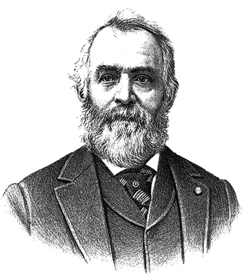 |
| Capt. Charles A. Hunt |
"Captain Hunt" — Captain Charles A. Hunt was born in New York on 17 Apr 1829, and in 1845 went west to establish a mill in Grant County, Wisconsin. When gold was discovered in California, he became a ’49er, but returned home after a year. In 1865 he purchased 300 acres in Monroe County, and help found the village of Melvina (named after his first wife). He joined the 25th Wisconsin when the Civil War broke out, and under the command of Sherman, was made a lieutenant and later a captain. In 1862 his unit was temporarily diverted to the suppression of the Dakota uprising in Minnesota. When the War was over, he adopted a number of orphan children of veterans. He was elected to the Assembly 1868-1870, and was appointed superintendent of the removal program in 1873. This was the last attempt at removal. He died 24 Aug 1899, and was given a stately funeral by the veterans of the Grand Army of the Republic.28
![]()
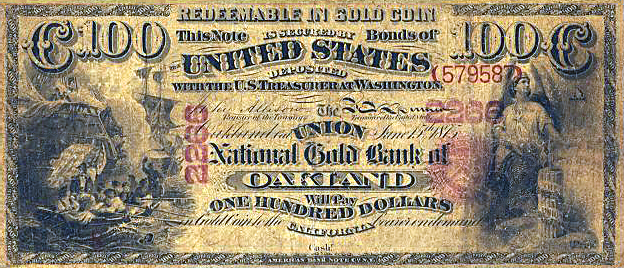 |
| An 1873 $100 Note |
"$200" — this amount in 1873 dollars would be about $3,976 in 2018 currency.
"Albion, Jackson County" — the township is located at 44.284722, -90.950000. The 1901 plat map of Jackson County, Township 22N, Range 3W, Section 29 SE shows Walking Cloud with 38.14 acres at Drummond Ford on the Black River, the center of which is at 44.351116, -90.769199.
"The Winnebagoes came from the sky" — this story is included in this collection as "First Contact, Version 3."
 |
| A Cedar Glade at Red Banks Reproduced with permission from the Department of Natural Resources |
"Red Banks" — Red Banks (Mógašúc) is located on Green Bay, Wisconsin (44.611111, -87.863056). It was the traditional place of origin for the Hocąk nation. See The Creation Council.
"the spirits might appear to them" — the story that follows is included in this collection as "Waterspirits Keep the Corn Fields Wet."
"a future life" — this story occurs in this collection as "Journey to Spiritland, Version 7."
Notes to the Commentary
1 Thomas J. George, Winnebago Vocabulary, 4989 Winnebago (Washington: Smithsonian Institution, National Anthropological Archives, 1885) p. 96. Informants: Big Bear of Friendship, Wisconsin, and Big Thunder. George's brief account is given in full in Four Legs.
2 Juliette Augusta McGill Kinzie, Wau-Bun, The "Early Day" in the North-west (Chicago & New York: Rand, McNally & Company, 1873 [1856]) 70-71.
3 Juliette Augusta McGill Kinzie, Wau-Bun, The "Early Day" in the North-west (Chicago & New York: Rand, McNally & Company, 1873 [1856]) 53.
4 Juliette Augusta McGill Kinzie, Wau-Bun, The "Early Day" in the North-west (Chicago & New York: Rand, McNally & Company, 1873 [1856]) 329.
5 John W. Hall, Uncommon Defense: Indian Allies in the Black Hawk War (Harvard University Press, 2009). Patrick J. Jung, The Black Hawk War of 1832 (Norman, Oklahoma: University of Oklahoma Press, 2007). Kerry A. Trask, Black Hawk: The Battle for the Heart of America (New York: Henry Holt and Company, 2006).
6 Moses Paquette, "The Wisconsin Winnebagoes," Wisconsin Historical Collections, XII (1892): 399-433 [426].
7 in the Index volume of Wisconsin Historical Collections, XX (1915): 478, s. nom.
8 Theron Royal Woodward, Dodge Genealogy: Descendants of Tristram Dodge (Chicago: Lanward Publishing Co., 1904) 60.
9 Louis Pelzer, Henry Dodge (Iowa City: State Historical Society of Iowa, 1911). Reuben Gold Thwaites, Notes to Wau-Bun, Caxton Club Edition (1901), 416 nt. 112.
10 Alfred Edward Bulger, "Events at Prairie du Chien Previous to American Occupation, 1814," Collections of the State Historical Society of Wisconsin, 13 (1895): 1-9 [1-2].
11 Bulger, "Events at Prairie du Chien Previous to American Occupation, 1814," 2.
12 Mary Elise Antoine, Prairie Du Chien (Charleston: Arcadia Publishing, 2011) 7.
13 Lurie, "A Check List of Treaty Signers by Clan Affiliation" (Kerεjúŋsεpgǝ, 61, #44).
14 Norton William Jipson, The Story of the Winnebagoes (Chicago: Chicago Historical Society [unpublished], 1924) 263.
15 "The Wisconsin Winnebagoes. An Interview with Moses Pauquette," Wisconsin Historical Collections, XII (1892): 399-433 [430-431].
16 Clark County Press, September 1899.
17 Owen Enterprise, January 6, 1921. For a Hawk Clan Warbundle, see "Artifacts."
18 Bruce E. Mahan, Old Fort Crawford and the Frontier (Iowa City: State Historical Society of Iowa, 1926).
19 James Lewis, The Black Hawk War of 1832 (Illinois Humanities Council, 2000).
20 Lurie, "A Check List of Treaty Signers by Clan Affiliation," 70, #105.
21 Black Hawk, Autobiography of Ma-ka-tai-me-she-kia-kiak, or Black Hawk, ed. John Barton Patterson (St. Louis: Continental Printing Co., 1882). William R. Smith, The History of Wisconsin, In Three Parts, Historical, Documentary and Descriptive, Part I, Vol. I (Madison: Beriah Brown, 1854) 221-406.
22 Reuben Gold Thwaites, Notes to Wau-Bun, Caxton Club Edition (1901), 404 nt. 49.
23 Lurie, "A Check List of Treaty Signers by Clan Affiliation," 71, #118.
24 Norton William Jipson, Story of the Winnebagoes (Chicago: The Chicago Historical Society, 1923 [unpublished]), 262.
25 Lurie, "A Check List of Treaty Signers by Clan Affiliation" (68, #91).
26 AOC (Architecture of the Capital) website, "Henry Mower Rice." Viewed: 2.28.2018.
27 Publius V. Lawson, "The Winnebago Tribe," Wisconsin Archeologist, 6, #3 (July, 1907) 78-162 [114].
28 Monroe County Democrat Friday, Sept. 1, 1899. Find a Grave website > "Charles A. Hunt." Viewed: 2.28.2018.
Source
"Narrative of Walking Cloud," Wisconsin Historical Collections, XIII (1895): 463-467.